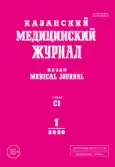Состояние адаптивного иммунитета слизистой оболочки двенадцатиперстной кишки при неонатальном сепсисе
- Авторы: Хаертынов Х.С.1, Анохин В.А.1, Бурганова Г.Р.2, Певнев Г.О.2, Мавликеев М.О.1, Киясов А.П.2, Ризванов А.А.2, Гильманов А.А.3, Любин С.А.3, Михеева Е.Г.1, Пшеничный П.В.2
-
Учреждения:
- Казанский государственный медицинский университет
- Казанский (Приволжский) федеральный университет
- Городская детская больница №1
- Выпуск: Том 101, № 1 (2020)
- Страницы: 31-39
- Тип: Теоретическая и клиническая медицина
- URL: https://journals.rcsi.science/kazanmedj/article/view/19427
- DOI: https://doi.org/10.17816/KMJ2020-31
- ID: 19427
Цитировать
Полный текст
Аннотация
Цель. Оценка показателей адаптивного иммунитета слизистой оболочки двенадцатиперстной кишки у детей с неонатальным сепсисом.
Методы. Проведено исследование биоптатов слизистой оболочки двенадцатиперстной кишки, полученных при проведении дуоденоскопии новорождённых, имевших признаки эрозивно-язвенного поражения пищеварительного тракта. 5 из них были получены от детей с клинико-лабораторными признаками неонатального сепсиса, 2 — от детей группы сравнения. Проведено иммуногистохимическое окрашивание биоптатов с использованием системы визуализации Novolink Polymer Detection System с коммерческими антителами к CD4, CD8, CD20 и Bcl-2 и системы визуализации CSAII Biotin-free Tyramide Signal Amplification System с коммерческими антителами к каспазе-3 и каспазе-9 в соответствии с инструкциями производителя.
Результаты. Было установлено, что количество Т-лимфоцитов CD4+ слизистой оболочки двенадцатиперстной кишки в группе новорождённых с сепсисом в 4 из 5 случаев не отличалось от показателей контрольной группы. Количество лимфоцитов CD8+ у детей с сепсисом в 3 из 5 случаев было даже бόльшим, чем в группе контроля. Количество B-лимфоцитов CD20+ у 4 детей с сепсисом было значительно меньше по сравнению с контролем. Установлена активация апоптоза в клетках слизистой оболочки у детей с сепсисом, что проявлялось бόльшим количеством каспаза-3-позитивных клеток (в 4 из 5 случаев) по сравнению с показателями контрольной группы. Количество каспаза-9-позитивных клеток в исследуемых группах было практически одинаковым. Отмечено значительное уменьшение количества Bcl-2-позитивных клеток слизистой оболочки у всех 5 детей с сепсисом по сравнению с показателями контрольной группы.
Вывод. Проведённое исследование выявило умеренно выраженную иммуносупрессию в слизистой оболочке двенадцатиперстной кишки у детей с неонатальным сепсисом, проявившуюся низкими значениями В-лимфоцитов CD20+ на фоне отсутствия значимого снижения количества Т-лимфоцитов CD4+ и CD8+; установлена умеренно выраженная активация процессов апоптоза на фоне сниженного антиапоптотического потенциала, что создаёт условия возможной транслокации кишечной микробиоты в кровоток.
Ключевые слова
Полный текст
Открыть статью на сайте журналаОб авторах
Халит Саубанович Хаертынов
Казанский государственный медицинский университет
Автор, ответственный за переписку.
Email: khalit65@rambler.ru
Россия, г. Казань, Россия
Владимир Алексеевич Анохин
Казанский государственный медицинский университет
Email: khalit65@rambler.ru
Россия, г. Казань, Россия
Гузель Рустамовна Бурганова
Казанский (Приволжский) федеральный университет
Email: khalit65@rambler.ru
Россия, г. Казань, Россия
Георгий Олегович Певнев
Казанский (Приволжский) федеральный университет
Email: khalit65@rambler.ru
Россия, г. Казань, Россия
Михаил Олегович Мавликеев
Казанский государственный медицинский университет
Email: khalit65@rambler.ru
Россия, г. Казань, Россия
Андрей Павлович Киясов
Казанский (Приволжский) федеральный университет
Email: khalit65@rambler.ru
Россия, г. Казань, Россия
Альберт Анатольевич Ризванов
Казанский (Приволжский) федеральный университет
Email: khalit65@rambler.ru
Россия, г. Казань, Россия
Альберт Альфредович Гильманов
Городская детская больница №1
Email: khalit65@rambler.ru
Россия, г. Казань, Россия
Сергей Анатольевич Любин
Городская детская больница №1
Email: khalit65@rambler.ru
Россия, г. Казань, Россия
Екатерина Геннадьевна Михеева
Казанский государственный медицинский университет
Email: khalit65@rambler.ru
Россия, г. Казань, Россия
Павел Витальевич Пшеничный
Казанский (Приволжский) федеральный университет
Email: khalit65@rambler.ru
Россия, г. Казань, Россия
Список литературы
- Verma P., Berwal P.K., Nagaraj N. et al. Neonatal sepsis: epidemiology, clinical spectrum, recent antimicrobial agents and their antibiotic susceptibility pattern. Int. J. Contemp. Pediatr. 2015; 2: 176–180. doi: 10.18203/2349-3291.ijcp20150523.
- Hotchkiss R.S., Osmon S.B., Chang K.C. et al. Accelerated lymphocyte death in sepsis occurs by both the death receptor and mitochondrial pathways. J. Immunol. 2005; 174: 5110–5118. doi: 10.4049/jimmunol.174.8.5110.
- Boomer J.S., To K., Chang K.C. et al. Immunosuppression in patients who die of sepsis and multiple organ failure. JAMA. 2011; 306 (23): 2594–605. doi: 10.1001/jama.2011.1829.
- Felmet K.A., Hall M.W., Clark R.S. et al. Prolonged lymphopenia, lymphoid depletion, and hypoprolactinemia in children with nosocomial sepsis and multiple organ failure. J. Immunol. 2005; 174: 3765–3772. doi: 10.4049/jimmunol.174.6.3765.
- Toti P., De Felice C., Occhini R. et al. Spleen depletion in neonatal sepsis and chorioamnionitis. Am. J. Clin. Pathol. 2004; 122: 765–771. doi: 10.1309/RV6E-9BMC-9954-A2WU.
- Меркулов Г.А. Курс патологогистологической техники. 4-е изд. Л.: Медгиз, ленинградское отделение. 1961; 343 с.
- Петров С.В., Райхлин Н.Т. Руководство по иммуногистохимической диагностике опухолей человека. Казань. 2004; 452 с.
- Wolk K., Kunz S., Crompton N.E. et al. Multiple mechanisms of reduced major histocompatibility complex class II expression in endotoxin tolerance. J. Biol. Chem. 2003; 278 (20): 18 030–18 036. doi: 10.1074/jbc.M207714200.
- Monneret G., Elmenkouri N., Bohe J. et al. Analytical requirements for measuring monocytic HLA-DR by flow cytometry. Clin. Chem. 2002; 48: 1589–1592. PMID: 12194941.
- Цинзерлинг А.В. Современные инфекции. Патологическая анатомия и вопросы патогенеза. СПб.: СОТИС. 1993; 363 с.
- Hotchkiss R.S., Coopersmith C.M., Karl I.E. Prevention of lymphocyte apoptosis — A potential treatment of sepsis? Clin. Inf. Dis. 2005; 41: 465–469. doi: 10.1086/431998.
- Hotchkiss R.S., Monneret G., Payen D. Sepsis-induced immunosuppression: from cellular dysfunctions to immunotherapy. Immunology. 2013; 13: 862–874. doi: 10.1038/nri3552.
- Hotchkiss R.S., Tinsley K.W., Swanson P.E. et al. Sepsis-induced apoptosis causes progressive profound depletion of B and CD4+ T lymphocytes in humans. J. Immunol. 2001; 166: 6952–6963. doi: 10.4049/jimmunol.166.11.6952.
- Da Silva F.P., Nizet V. Cell death during sepsis: integration of disintegration in the inflammatory response to overwhelming infection. Apoptosis. 2009; 14: 509–521. doi: 10.1007/s10495-009-0320-3.
- Hotchkiss R.S., Tinsley K.W., Karl I.E. Role of apoptotic cell death in sepsis. Scand. J. Infect. Dis. 2003; 35: 585–592. doi: 10.1080/00365540310015692.
Дополнительные файлы








